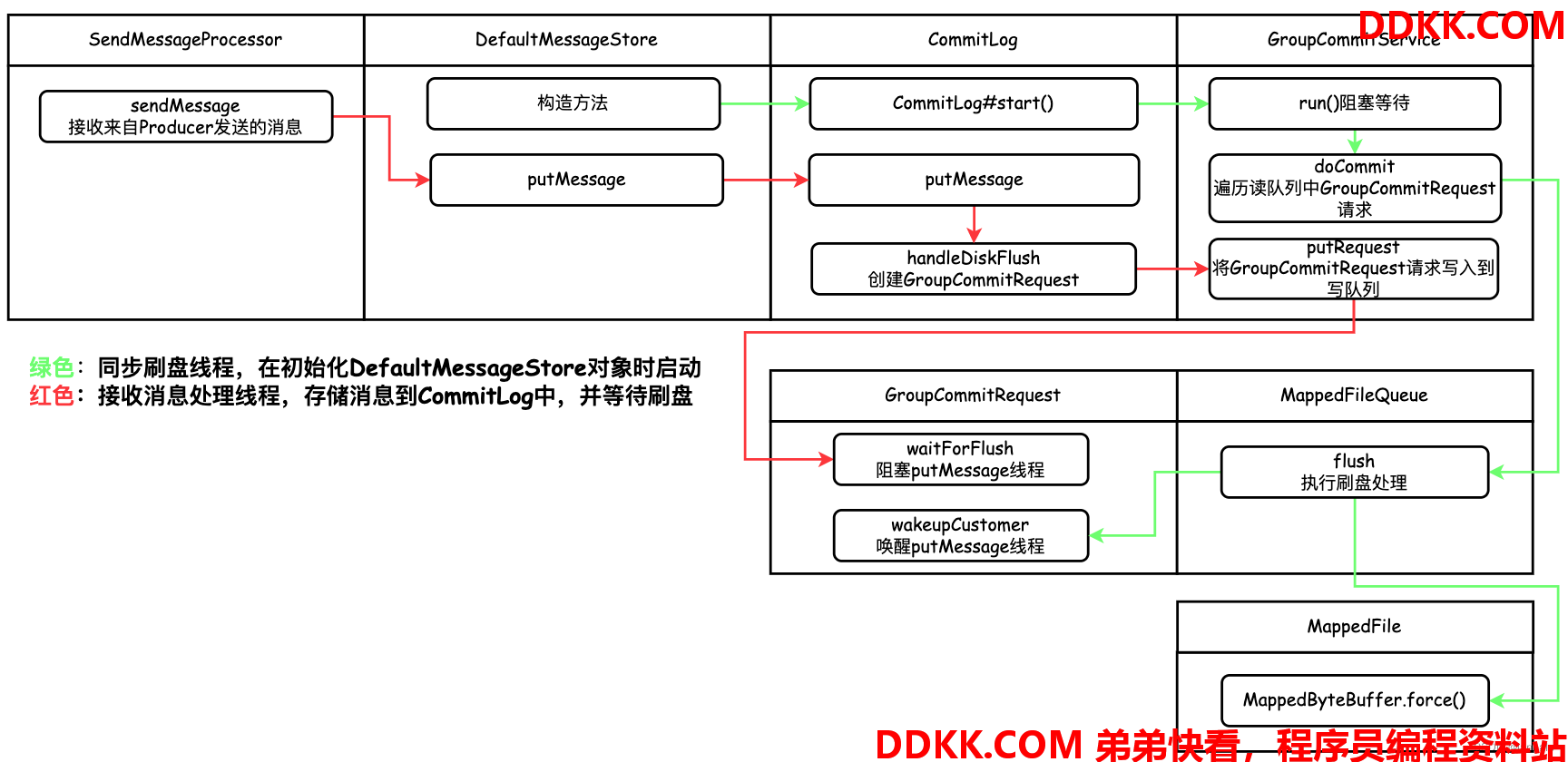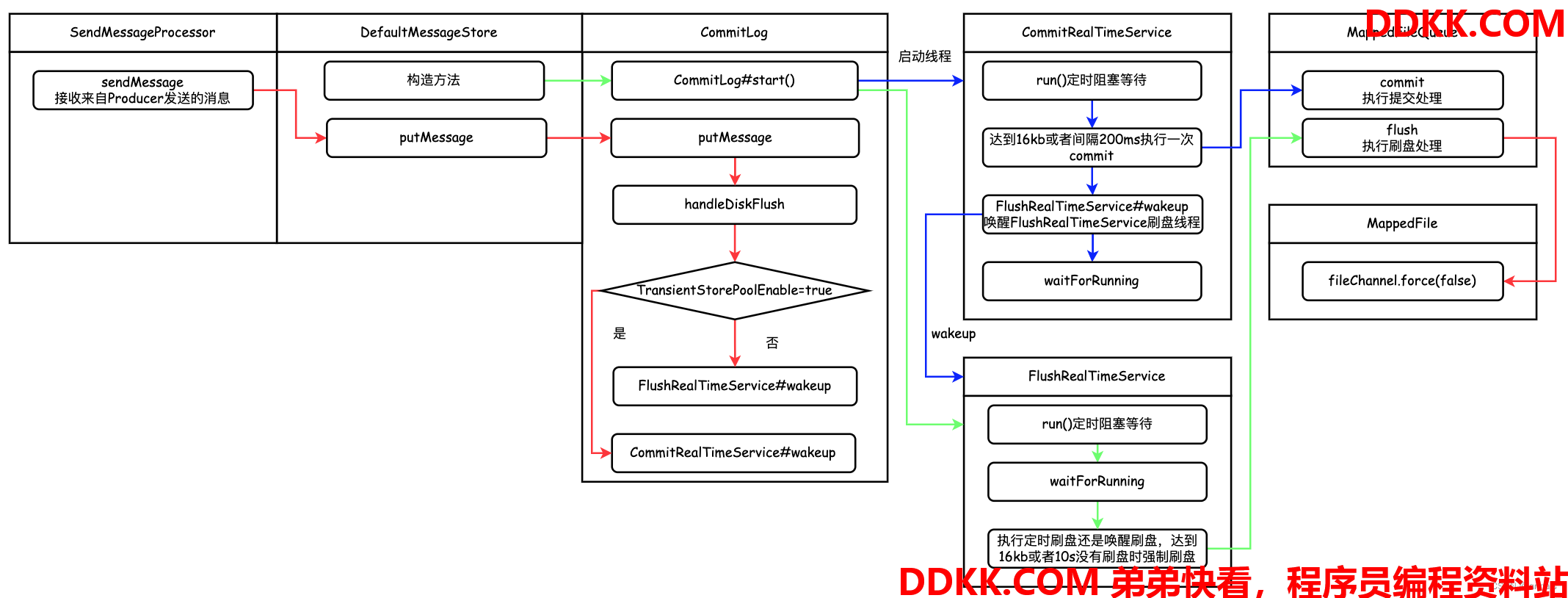版本
基于rocketmq-all-4.3.1版本;
简介
1、 RocketMQ消息存储是首先将消息追加到内存中,然后根据刷盘策略在不同时间刷盘;
- 同步刷盘,消息追加到内存,调用**MappedByteBuffer.force()**方法实现刷盘
- 异步刷盘,消息追加到内存后,立即返回给Producer。使用单独的异步线程按照一定的频率执行刷盘操作
2、 Index文件的刷盘并不是采取定时刷盘机制,而是每更新一次Index文件就会将上一次的改动写入磁盘;
3、 刷盘代码CommitLog#handleDiskFlush,可以看到同步刷盘由GroupCommitService完成
public void handleDiskFlush(AppendMessageResult result, PutMessageResult putMessageResult, MessageExt messageExt) {
//刷盘策略,同步刷盘阻塞等待,异步刷盘唤醒commitLogService
// Synchronization flush
if (FlushDiskType.SYNC_FLUSH == this.defaultMessageStore.getMessageStoreConfig().getFlushDiskType()) {
final GroupCommitService service = (GroupCommitService) this.flushCommitLogService;
if (messageExt.isWaitStoreMsgOK()) {
//构建刷盘请求放入GroupCommitService队列中(List中)
GroupCommitRequest request = new GroupCommitRequest(result.getWroteOffset() + result.getWroteBytes());
service.putRequest(request);
//GroupCommitService线程在broker启动时会启动,阻塞,等待线程刷盘完成,默认超时时间5s,如果超时返回false
//即如果超时,响应给生产者的是FLUSH_DISK_TIMEOUT
boolean flushOK = request.waitForFlush(this.defaultMessageStore.getMessageStoreConfig().getSyncFlushTimeout());
if (!flushOK) {
log.error("do groupcommit, wait for flush failed, topic: " + messageExt.getTopic() + " tags: " + messageExt.getTags()
+ " client address: " + messageExt.getBornHostString());
putMessageResult.setPutMessageStatus(PutMessageStatus.FLUSH_DISK_TIMEOUT);
}
} else {
service.wakeup();
}
}
// Asynchronous flush
else {
if (!this.defaultMessageStore.getMessageStoreConfig().isTransientStorePoolEnable()) {
//使用MappedByteBuffer,默认策略
flushCommitLogService.wakeup();
} else {
//异步刷盘,如果开启TransientStorePool,使用写入缓冲区+FileChannel
commitLogService.wakeup();
}
}
}
FlushCommitLogService
1、 UML图 ;
;
2、 实现类;
CommitRealTimeService:异步刷盘并且transientStorePoolEnable设置为trueFlushRealTimeService:异步刷盘并且transientStorePoolEnable设置为falseGroupCommitService:同步刷盘
3、FlushCommitLogService没有任何实现,只是定义了一个常量;
abstract class FlushCommitLogService extends ServiceThread {
protected static final int RETRY_TIMES_OVER = 10;
}
同步刷盘
1、 同步刷盘指的是在消息追加到内存映射文件(MappedByteBuffer)的内存中后,立即将数据从内存写入磁盘文件(MappedByteBuffer.force());
GroupCommitService
1、 同步刷盘由GroupCommitService完成;
- 第一步:构建刷盘请求对象
GroupCommitRequest,并将对象添加到requestsWrite队列中 - 第二步:默认等待5s,如果返回false,响应给生产者的是
FLUSH_DISK_TIMEOUT
2、GroupCommitService有一个写队列和一个读队列,即将请求和刷盘进行读写分离请求提交到写列表,刷盘时处理读列表,刷盘结束交换列表,循环往复;

3、GroupCommitRequest;
public static class GroupCommitRequest {
private final long nextOffset;
private final CountDownLatch countDownLatch = new CountDownLatch(1);
//刷盘结果
private volatile boolean flushOK = false;
public GroupCommitRequest(long nextOffset) {
this.nextOffset = nextOffset;
}
public long getNextOffset() {
return nextOffset;
}
//唤醒阻塞等待的线程
//FIXME by jannal 此处有并发问题,this.flushOK = flushOK不是原子操作。正常需要加同步
//由于只有一个线程操作,所以即使不是原子性也问题不大
public void wakeupCustomer(final boolean flushOK) {
this.flushOK = flushOK;
this.countDownLatch.countDown();
}
//等待刷盘
public boolean waitForFlush(long timeout) {
try {
this.countDownLatch.await(timeout, TimeUnit.MILLISECONDS);
return this.flushOK;
} catch (InterruptedException e) {
log.error("Interrupted", e);
return false;
}
}
}
4、GroupCommitService源码分析;
class GroupCommitService extends FlushCommitLogService {
//读写容器
private volatile List<GroupCommitRequest> requestsWrite = new ArrayList<GroupCommitRequest>();
private volatile List<GroupCommitRequest> requestsRead = new ArrayList<GroupCommitRequest>();
public synchronized void putRequest(final GroupCommitRequest request) {
//FIXME by jannal 思考:既然方法已经加锁,为什么此处需要再次加锁?
//swapRequests可能在其他线程并发执行,所以需要给requestsWrite单独加锁
//swapRequests导致requestsWrite的引用变化,会不会出现问题?
//可以将swapRequests加一个与操作requestsWrite的锁,来优化此处代码,避免不好理解
synchronized (this.requestsWrite) {
this.requestsWrite.add(request);
}
// 通知服务线程已经接收到GroupCommitRequest
//FIXME 直接调用父类的this.wakeUp()多好?
if (hasNotified.compareAndSet(false, true)) {
waitPoint.countDown(); // notify
}
}
private void swapRequests() {
// volatile可以保证可见性,requestsWrite写入时加锁了,所以此处无需加锁,通过volatile可以实现低开销的读
List<GroupCommitRequest> tmp = this.requestsWrite;
this.requestsWrite = this.requestsRead;
this.requestsRead = tmp;
}
private void doCommit() {
synchronized (this.requestsRead) {
if (!this.requestsRead.isEmpty()) {
for (GroupCommitRequest req : this.requestsRead) {
// There may be a message in the next file, so a maximum of
// two times the flush
boolean flushOK = false;
/**
* 两个MappedFile(写第N个消息时,MappedFile 已满,创建了一个新的),所以需要有循环2次。
*/
for (int i = 0; i < 2 && !flushOK; i++) {
//请求的offset超过已经flushed的offset,则强制刷盘
flushOK = CommitLog.this.mappedFileQueue.getFlushedWhere() >= req.getNextOffset();
if (!flushOK) {
CommitLog.this.mappedFileQueue.flush(0);
}
}
req.wakeupCustomer(flushOK);
}
long storeTimestamp = CommitLog.this.mappedFileQueue.getStoreTimestamp();
if (storeTimestamp > 0) {
//更新刷盘检测点StoreCheckpoint中的physicMsg Timestamp
//刷盘检测点的刷盘操作将在刷写消息队列文件时触发
CommitLog.this.defaultMessageStore.getStoreCheckpoint().setPhysicMsgTimestamp(storeTimestamp);
}
this.requestsRead.clear();
} else {
// Because of individual messages is set to not sync flush, it
// will come to this process
CommitLog.this.mappedFileQueue.flush(0);
}
}
}
public void run() {
CommitLog.log.info(this.getServiceName() + " service started");
while (!this.isStopped()) {
try {
//调用swapRequests=>doCommit
this.waitForRunning(10);
this.doCommit();
} catch (Exception e) {
CommitLog.log.warn(this.getServiceName() + " service has exception. ", e);
}
}
// Under normal circumstances shutdown, wait for the arrival of the
// request, and then flush
try {
Thread.sleep(10);
} catch (InterruptedException e) {
CommitLog.log.warn("GroupCommitService Exception, ", e);
}
//FIXME by jannal 上面没有加锁,这里为啥加锁?
synchronized (this) {
this.swapRequests();
}
this.doCommit();
CommitLog.log.info(this.getServiceName() + " service end");
}
@Override
protected void onWaitEnd() {
this.swapRequests();
}
@Override
public String getServiceName() {
return GroupCommitService.class.getSimpleName();
}
@Override
public long getJointime() {
return 1000 * 60 * 5;
}
}
异步刷盘
- CommitLog#handleDiskFlush中异步刷盘代码如下。异步刷盘有两种方式
- 开启
transientStorePoolEnable=true机制则启动CommitRealTimeService异步刷盘方式。 - 如果没有开启
transientStorePoolEnable=false,则启动FlushRealTimeService - CommitRealTimeService在commit成功后,会执行
flushCommitLogService.wakeup();也就是让FlushRealTimeService将Page Cache中的数据同步至磁盘。
if (!this.defaultMessageStore.getMessageStoreConfig().isTransientStorePoolEnable()) {
//使用MappedByteBuffer,默认策略
flushCommitLogService.wakeup();
} else {
//异步刷盘,如果开启TransientStorePool,使用写入缓冲区+FileChannel
commitLogService.wakeup();
}
2、 异步刷盘流程;

CommitRealTimeService
1、 如果transientStorePoolEnable=true,Broker会申请一个与CommitLog同样大小的堆外内存,该堆外内存会使用内存锁定(mlock) ,将其变为常驻内存,避免被操作系统调到swap空间中;
- 消息追加到堆外内存
- 提交到内存映射文件中
- 使用flush刷盘
2、CommitRealTimeService服务线程执行逻辑;
- 默认每200ms将ByteBuffer新追加的数据(
新追加的数据=wrotePosition-commitedPosition)提交到FileChannel中
FlushRealTimeService
1、 无论是否开启写入缓冲池,刷盘最终都由FlushRealTimeService来执行,CommitRealTimeService在commit成功后,会执行flushCommitLogService.wakeup();也就是让FlushRealTimeService将PageCache中的数据同步至磁盘;
2、 将内存(PageCache)中的数据同步至磁盘(flush)有一些前提条件;
-
若当前时间距离上次实际刷盘时间已经超过10S,则会忽略其他所有前提,确定刷盘,这样即使服务器宕机了最多也仅丢失10S的数据,提高了消息队列的可靠性。
-
正常情况下刷盘需要满足持久化数据大于配置的最小页数,默认4,也就是新写入内存中的数据大于或等于16KB(4*4KB)
- 当开启写入缓冲,也就是追加到fileChannel的数据大于或等于16KB
- 未开启写入缓冲则是追加到mappedByteBuffer的数据大于或等于16KB